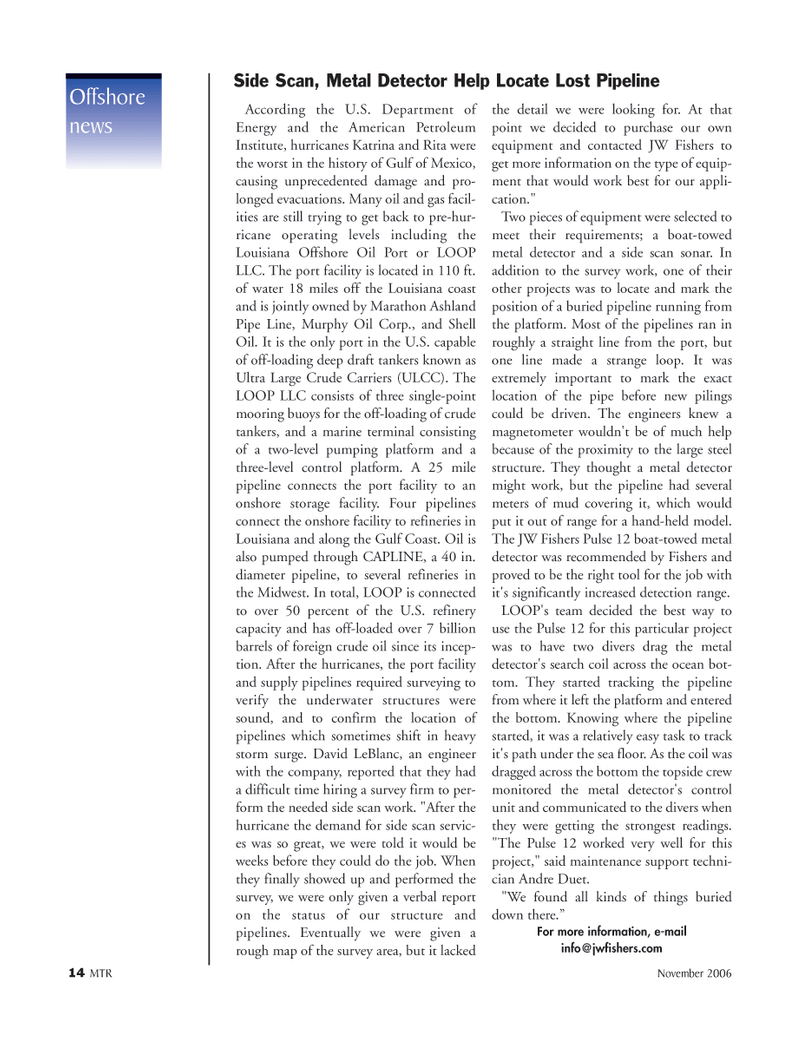
Page 14: of Marine Technology Magazine (November 2006)
Deep Ocean Exploration
Read this page in Pdf, Flash or Html5 edition of November 2006 Marine Technology Magazine
14 MTR November 2006
Offshore news
According the U.S. Department of
Energy and the American Petroleum
Institute, hurricanes Katrina and Rita were the worst in the history of Gulf of Mexico, causing unprecedented damage and pro- longed evacuations. Many oil and gas facil- ities are still trying to get back to pre-hur- ricane operating levels including the
Louisiana Offshore Oil Port or LOOP
LLC. The port facility is located in 110 ft. of water 18 miles off the Louisiana coast and is jointly owned by Marathon Ashland
Pipe Line, Murphy Oil Corp., and Shell
Oil. It is the only port in the U.S. capable of off-loading deep draft tankers known as
Ultra Large Crude Carriers (ULCC). The
LOOP LLC consists of three single-point mooring buoys for the off-loading of crude tankers, and a marine terminal consisting of a two-level pumping platform and a three-level control platform. A 25 mile pipeline connects the port facility to an onshore storage facility. Four pipelines connect the onshore facility to refineries in
Louisiana and along the Gulf Coast. Oil is also pumped through CAPLINE, a 40 in. diameter pipeline, to several refineries in the Midwest. In total, LOOP is connected to over 50 percent of the U.S. refinery capacity and has off-loaded over 7 billion barrels of foreign crude oil since its incep- tion. After the hurricanes, the port facility and supply pipelines required surveying to verify the underwater structures were sound, and to confirm the location of pipelines which sometimes shift in heavy storm surge. David LeBlanc, an engineer with the company, reported that they had a difficult time hiring a survey firm to per- form the needed side scan work. "After the hurricane the demand for side scan servic- es was so great, we were told it would be weeks before they could do the job. When they finally showed up and performed the survey, we were only given a verbal report on the status of our structure and pipelines. Eventually we were given a rough map of the survey area, but it lacked the detail we were looking for. At that point we decided to purchase our own equipment and contacted JW Fishers to get more information on the type of equip- ment that would work best for our appli- cation."
Two pieces of equipment were selected to meet their requirements; a boat-towed metal detector and a side scan sonar. In addition to the survey work, one of their other projects was to locate and mark the position of a buried pipeline running from the platform. Most of the pipelines ran in roughly a straight line from the port, but one line made a strange loop. It was extremely important to mark the exact location of the pipe before new pilings could be driven. The engineers knew a magnetometer wouldn't be of much help because of the proximity to the large steel structure. They thought a metal detector might work, but the pipeline had several meters of mud covering it, which would put it out of range for a hand-held model.
The JW Fishers Pulse 12 boat-towed metal detector was recommended by Fishers and proved to be the right tool for the job with it's significantly increased detection range.
LOOP's team decided the best way to use the Pulse 12 for this particular project was to have two divers drag the metal detector's search coil across the ocean bot- tom. They started tracking the pipeline from where it left the platform and entered the bottom. Knowing where the pipeline started, it was a relatively easy task to track it's path under the sea floor. As the coil was dragged across the bottom the topside crew monitored the metal detector's control unit and communicated to the divers when they were getting the strongest readings. "The Pulse 12 worked very well for this project," said maintenance support techni- cian Andre Duet. "We found all kinds of things buried down there.”
For more information, e-mail [email protected]
Side Scan, Metal Detector Help Locate Lost Pipeline
MTR#9 (1-16).qxd 11/14/2006 11:51 AM Page 16

 13
13

 15
15
